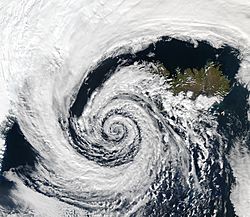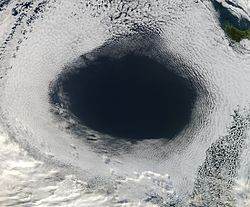Pressure system facts for kids
A pressure system is a region of the Earth's atmosphere where air pressure is unusually high or low. High and low pressures form (and die) constantly due to water and air interactions of the atmosphere and water in oceans, lakes, and other bodies of water.
Pressure systems on weather maps
On weather maps, which often display weather fronts and pressure systems graphically, low-pressure systems are depicted with a capital L, unless they are tropical storms or tropical cyclones (in which case the symbols for those weather systems are used). High-pressure systems are depicted with an H. The steepness of the pressure gradient can be observed according to the density of isobars, or lines on the map at which pressure is equal.
Low-pressure system

The components of storms are attracted to regions of low pressure. For this reason, heavy precipitation and overcast conditions are often associated with low-pressure systems. Due to the Coriolis effect, low-pressure systems often develop cyclonic properties: in the northern hemisphere, winds around the system move counterclockwise, and in the southern hemisphere they move clockwise. Low pressure systems, additionally, often become junctures of fronts.
Most of history's most powerful storms, such as the 1993 North American storm complex and all tropical cyclones, have been low-pressure cyclonic systems. Tornadoes invariantly have very strong local low-pressure systems at their vortices.
High-pressure system
High pressure systems are associated with clear, cool weather. Around high-pressure systems, winds flow anticyclonically— that is, clockwise in the northern hemisphere, counterclockwise in the southern hemisphere.
In the northern winter, high-pressure systems (called Canadian highs or arctic air masses) often migrate to midlatitude regions such as the North American upper Midwest, New England, and northern Europe. These create cold snaps where unseasonably cold and sunny weather are observed. Cold snaps often follow winter warm spells, where temperatures may be as high as 10°C to 20°C (50-68 °F), and often happen suddenly. The most dramatic arctic cold snaps, observed in the central regions of North America involve temperature drops of 25°C (45°F) or more in a few hours.
Arctic highs, alone, rarely trigger precipitation because of the cloudless weather they produce. However, in combination with other weather-making systems, the cold air they bring can produce massive snowstorms.
Images for kids




